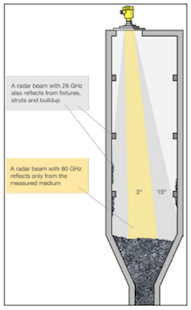
There are certain foundational things all operators need to know about their process instrumentation. Degree of accuracy, installation ease, and maintenance frequency are just three must-have pieces of info users should consider when seeking a level technology. Once the broad, basic needs are met, users can start considering the specific needs of their application.
This paper will review three of the most common considerations users make when choosing a level measurement technology for a bulk solids application. It’s important to note that this paper will not cover every consideration that operators and engineers use to make decisions. Instrument cost, for example, is an important factor that deserves serious deliberation; however, we will focus on the compatibility of common characteristics and level measurement technology. In the interest of space, some basic operational knowledge is assumed.
Product properties
When one is choosing a bulk solid level measurement, it’s wise to begin with the product one is trying to measure. Some solids, like coal and sand, are highly reflective and easily measured by radar sensors. Conversely, poorly-reflective products—polystyrene pellets, for example—may require a guided wave sensor or a through-air radar with high dynamic range.
Particle size is also a consideration in bulk solids level measurement. The absorption properties of a material are related to particle size, and can go a long way in determining available measurement technologies. Historically, radar sensors have had trouble detecting small particles, but new, high-frequency sensors measure them reliably. Radiation-based systems and yo-yo instruments also perform well in applications with small particles.
Abrasive solids are a nightmare for mechanical devices and other level instruments that operate by contact as they can damage the intrusive parts of the device. Buildup is also no picnic for yo-yos and other technologies with moving parts, as it typically creates costly and time-consuming maintenance programs. On the other hand, radar and other non-contact technologies are unaffected by abrasive solids, and those with the latest STC functions and high dynamic range can filter out signals caused by buildup as well. This is particularly advantageous for users who want to continue level measurement during dusty filling cycles.

Radar sensors using a higher 80 GHz frequency have better focus, which helps to provide a more accurate level measurement.
The near photo shows the antenna of a VEGAPULS 69 sensor used to measure hydrated lime. Even through that mess, the product gives an accurate, reliable level reading.
Process conditions
The phrase “process conditions” can mean just about anything. It might refer to ambient temperature, process temperature, pressure inside or outside of a vessel; just about any reality of a process can fall under the catch-all label of process conditions.
Different process conditions can eliminate level technologies from consideration. Non-contact radar, guided wave sensors, and yo-yo instruments for example, perform better in extreme temperatures than ultrasonic devices. Radiation-based level technology is immune to process pressure limitations, while yo-yo systems only perform reliably in low-pressure applications.
Some level technologies perform better in challenging conditions than others. Before making a purchase decision, users should educate themselves on how their current level instruments historically hold up in process conditions like theirs. What they’ll likely find is instead of choosing between a dozen or so level measurement options, they will only have to choose between two or three.
Vessel construction
The shape and construction of a vessel in a bulk solids application is easy to overlook, but incredibly important. Internal fixtures and struts are a challenge for some level instruments because they can create false readings and, by extension, a much more demanding experience for the user. Even within categories of level technology, performance with obstructions is a problem. Take radar sensors, for example: Some instruments emit a wide beam angle that contacts internals. Conversely, modern, high-frequency sensors miss them by releasing a more focused beam. Struts and other vessel obstructions are of little concern with guided wave radar, radiation-based systems, or yo-yo instruments.
The location of process connections is also a crucial consideration when choosing a level instrument, as modifying a vessel so it’s compatible with an instrument can come at a great expense. There’s an optimal vessel placement for every level technology. Through-air radar, ultrasonic sensors, and yo-yo systems work only from the top-down. On the other hand, mechanical paddles and vibrating switches that are common in point level applications are often installed on a vessel’s side. Mounting location is also very important to radiation-based systems.
Conclusion
All level technologies have their strengths and weaknesses, and different conditions may narrow the field of compatible process instruments. It’s in the best interests of operators and engineers to consider product properties, process conditions, and vessel construction when assessing level measurement options. They may find that there is a better technology available for their bulk solids process.
VEGA
www.vega.com
Print this page